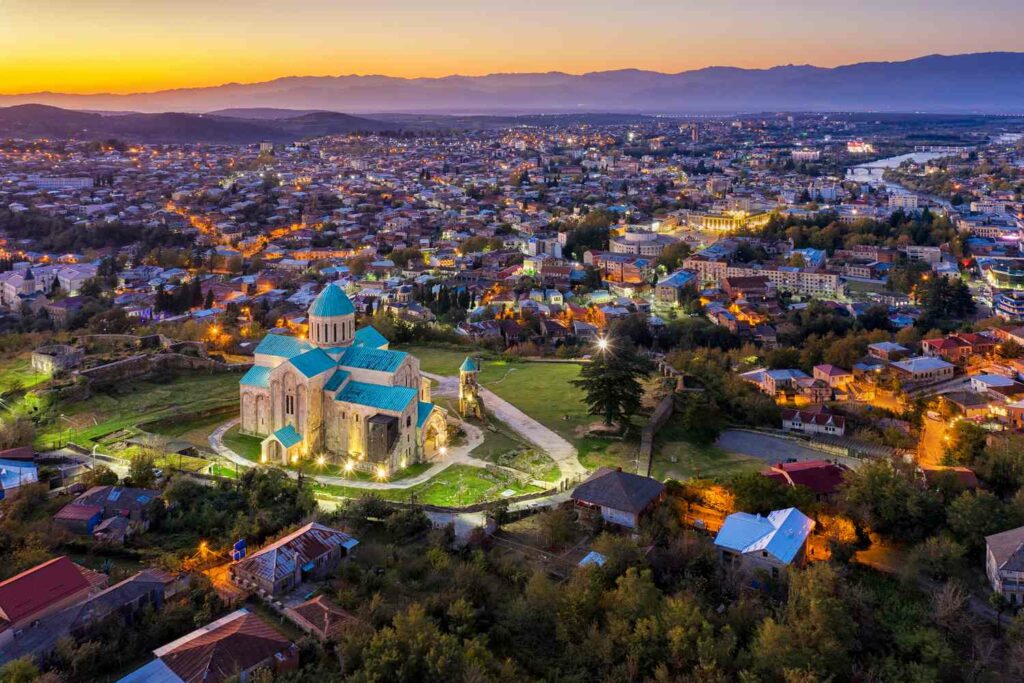Kutaisi, Georgia: Unveiling the Ancient Majesty, Cultural Resilience, and Natural Beauty of the Colchis Capital

Introduction:
Kutaisi, the ancient capital of Colchis and the legislative capital of modern Georgia, unfolds as a captivating city where millennia of history, cultural resilience, and natural beauty converge. Nestled along the banks of the Rioni River and surrounded by lush landscapes, Kutaisi stands as a testament to the enduring spirit of Georgia. In this extensive exploration, we delve into the layers of Kutaisi, from its archaeological treasures and historic landmarks to its vibrant cultural scene, culinary delights, and the unspoiled allure of its surroundings.
Section 1: Archaeological Treasures – Bridging Ancient and Modern
1.1 Gelati Monastery: Gelati Monastery, a UNESCO World Heritage site, stands as a beacon of Georgian medieval architecture and spirituality. Founded by King David IV in the 12th century, the monastery complex includes a cathedral adorned with frescoes, a royal academy, and the tombs of prominent Georgian kings. Gelati Monastery is not just a historical relic but a living testament to the cultural and religious significance of Kutaisi.
1.2 Bagrati Cathedral: Bagrati Cathedral, perched on Ukimerioni Hill, offers panoramic views of Kutaisi and the surrounding landscapes. Built in the 11th century by Bagrat III, the cathedral combines Byzantine and Georgian architectural elements. Despite undergoing restoration in recent years, Bagrati Cathedral retains its majestic presence, serving as an iconic symbol of Kutaisi’s rich history.
1.3 Sataplia Nature Reserve: Sataplia Nature Reserve, located near Kutaisi, is a geological marvel that transports visitors back to the time of dinosaurs. The reserve is home to dinosaur footprints, karst caves, and lush forests. A walk through Sataplia reveals the prehistoric wonders hidden within the natural landscape, offering a unique blend of archaeology and natural beauty.
Section 2: Historic Landmarks – Guardians of the Past
2.1 Kutaisi State Historical Museum: The Kutaisi State Historical Museum is a repository of Georgia’s past, housing artifacts that span centuries. From archaeological finds to exhibits on the country’s medieval and Soviet periods, the museum provides a comprehensive journey through Kutaisi’s role in shaping Georgia’s cultural and political identity.
2.2 Colchis Fountain: The Colchis Fountain, located in the heart of Kutaisi, pays homage to the mythical past of the region. Depicting scenes from the Greek myth of Jason and the Argonauts, the fountain serves as a visual representation of Colchis, a land associated with the Golden Fleece and the legendary journey of the Argonauts.
2.3 White Bridge: The White Bridge, spanning the Rioni River, is a picturesque landmark that connects the historic and modern quarters of Kutaisi. With its elegant arches and panoramic views of the city, the bridge is not just a practical crossing but a cultural icon that encapsulates the city’s charm and architectural legacy.
Section 3: Vibrant Cultural Scene – Nurturing Art and Tradition
3.1 Meskhishvili Theatre: Meskhishvili Theatre, one of Kutaisi’s cultural gems, has been a hub for theatrical performances since the late 19th century. Renowned for its unique blend of Georgian and European theatrical traditions, Meskhishvili Theatre continues to enrich Kutaisi’s cultural landscape with a repertoire that spans classical and contemporary works.
3.2 Kutaisi International Short Film Festival: The Kutaisi International Short Film Festival, an annual event, brings filmmakers and cinephiles together to celebrate the art of short filmmaking. The festival, held in various historic venues across the city, showcases diverse cinematic voices and fosters a vibrant cultural exchange within Kutaisi.
3.3 Tsisperi Kantselebi Theatre: Tsisperi Kantselebi Theatre, founded in the 1990s, has become a cornerstone of Kutaisi’s cultural scene. With its avant-garde performances, experimental plays, and a commitment to pushing artistic boundaries, the theatre contributes to Kutaisi’s reputation as a city where tradition and innovation coalesce.
Section 4: Culinary Delights – A Gastronomic Odyssey
4.1 Imeretian Cuisine: Kutaisi, situated in the heart of the Imereti region, is a culinary haven that delights the senses with authentic Imeretian cuisine. Local specialties such as khachapuri (cheese-filled bread), pkhali (vegetable and nut spreads), and shkmeruli (garlic-fried chicken) showcase the rich flavors of the region.
4.2 Kutaisi Central Market: The Kutaisi Central Market, a bustling hub of commerce and gastronomy, invites visitors to explore the vibrant tapestry of local produce and culinary delights. From colorful fruits and vegetables to fresh cheeses and spices, the market provides a sensory journey through the flavors of Kutaisi.
4.3 Wine Cellars: Kutaisi, nestled within the cradle of Georgian winemaking traditions, offers a unique opportunity to explore traditional wine cellars. Visitors can savor the local wines, often produced through ancient qvevri winemaking methods, and immerse themselves in the cultural significance of wine in Georgian society.
Section 5: Natural Beauty – The Enchanting Surroundings
5.1 Prometheus Cave: Located near Kutaisi, Prometheus Cave is a subterranean wonder that captivates with its stalactites, stalagmites, and underground rivers. Illuminated with colorful lights, the cave creates an otherworldly atmosphere, inviting visitors to embark on a journey through its chambers and experience the magic of nature’s architecture.
5.2 Okatse Canyon: Okatse Canyon, a natural masterpiece near Kutaisi, offers breathtaking views of cascading waterfalls, lush greenery, and the Rioni River Gorge. The recently constructed Okatse Skywalk provides a thrilling vantage point, allowing visitors to gaze upon the canyon’s majestic beauty from a suspended platform.
5.3 Martvili Canyon: Martvili Canyon, characterized by emerald-green waters and towering cliffs, provides an idyllic setting for nature enthusiasts. Boat tours through the canyon’s waters reveal hidden grottoes, lush vegetation, and the tranquil ambiance that defines this natural sanctuary.
Conclusion:
Kutaisi, with its ancient majesty, cultural resilience, and natural beauty, emerges as a city that encapsulates the essence of Georgia. From the archaeological treasures of Gelati Monastery to the culinary delights of Imeretian cuisine, Kutaisi invites residents and visitors alike to embark on a multifaceted journey through time and culture. As the city continues to evolve, it remains a testament to Georgia’s enduring spirit, offering a harmonious blend of history, tradition, and natural wonders that define Kutaisi as a captivating destination at the crossroads of the past and the future.




